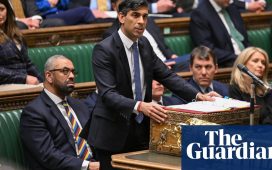Claim
Labour “was responsible for the massive rise in homelessness”, the chancellor, Sajid Javid, has said.
Background
In an interview with Sky News Javid said that homelessness had peaked in 2008 under a Labour government. He said it had halved since then.
He said that when he was housing secretary the government had prioritised cutting homelessness.
Sky News
(@SkyNews)“It’s Labour that was responsible for the massive rise of homelessness.”
Chancellor @sajidjavid claims that the previous Labour government is to blame for the UK’s rise in homelessness.
Labour’s pledged to end rough sleeping in the #GE2019 campaign: https://t.co/xUdNCUIw2l pic.twitter.com/yQ5IPIoMPB
Reality
Official figures showed that in 2017/18, 56,600 households were accepted as being in priority need of housing. That figure is below the peak of 135,000 recorded in 2003/04 under a Labour government, but an increase from the 40,000 in the year before the coalition government came into power.
Figures for the number of households in temporary accommodation, including B&Bs and hostels, showed a similar trajectory. According to the Ministry of Housing, Communities and Local Government, there were 84,740 households in temporary accommodation in the first quarter of 2019, including 126,020 children.
The same figures showed that under the last Labour government the number rose and then fell, peaking at 101,300 in 2004, before dropping to 50,400 by the time the coalition government came into power.
The number of households seeking help continues to grow. Between January and March this year, 32,740 households were initially assessed as being homeless, up 11.2% from 29,430 in the previous quarter.
Rough sleeping figures are hard to pin down. The official numbers are based on a count done on a single night each year. They showed that in autumn 2018 there were 4,677 people on the streets, up from 1,768 in 2010.
Some of the problems have been in place for a long time and have continued under successive governments. The sell-off of council housing under right to buy has eroded the number of homes available at the lowest rents, while housebuilding has predominantly been left to private companies.
Meanwhile, the relaxation of rules governing buy-to-let mortgages and the fall in interest rates after the financial crash have brought more private landlords into the market. One in five people who become homeless have had to move at the end of an assured shorthold tenancy, so the rise of the private rented sector and the loss of long social tenancies has had an impact.
But so too has a change in the definition of “affordable rent” introduced by the Conservative party. It allowed housing associations to offer homes for up to 80% of market rents, rather than pegging costs to local incomes, and has led to a shift in the type of properties they build and provide.
Last year, 6,463 of the “affordable” homes that were built were to be let at the traditional social rent, while 26,838 were to be available at the higher “affordable rent”.
Changes to local housing allowance, which froze payments, together with the benefits cap, the move to universal credit, and the withdrawal of housing benefits for young adults have also added to the number of people struggling to afford somewhere to live.
Recently, the Chartered Institute of Housing found that housing associations were denying housing to homeless people who they feared would fall behind on rent.
Figures for homelessness are never entirely accurate – government data captures the number of households who have been accepted by their local council as in need of accommodation, or the number of rough sleepers on a given night, but this is not the whole picture.
The number of people sofa-surfing, or living in overcrowded family accommodation because they have no other option is impossible to capture. The housing charity Shelter has estimated that the overall 277,000 people are homeless in England on a given night.
Verdict
Homelessness did rise under Labour – but it had fallen by the time the Conservatives came to power and has increased since. Javid’s claim is misleading.













